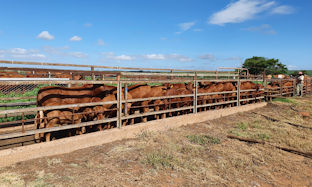
MANAGEMENT OF BEEF CALVES WEANING TIME: Introduction
Article 1 of 7 in the series on Weaning
Weaning time is "harvest time" on a commercial beef farm. We should do everything in our power to make this action go as smoothly as possible and negotiate the best possible price for the calves.
One of the first actions to be taken in the run-up to weaning time, is to consider the possible marketing options. The most important aspects to consider are the expected weaner price and the feed:meat price ratio. Since maize (or hominy chop) is the largest component and cost of a feedlot ration, it is essentially the maize:slaughter price ratio. In order to feed profitably, the rule of thumb is that 1 kg of meat must be able to purchase at least 14 kg of maize. A maize:meat price ratio of more than 14:1 is therefore desired. If the expected weaner calf price is not very favorable but the maize/slaughter price is, consideration can be given to finishing off calves yourself - if the other resources are available.
The optimal weaning weight of calves is also always a point of discussion. It is the case that lighter calves', the price per kilogram of body mass is higher than that of heavier calves. However, this does not mean that marketing calves earlier is necessarily the best option (most profitable). There are many factors that must be taken into account that can affect a producer's decision. In most cases, weight beats price. But then one has to take into account the condition of the cows, as well as the quality and availability of the pasture, as well as the extra costs associated with lick supplementation and the treatment costs of parasites, if calves are weaned later. Although calves are no longer very dependent on the cow's milk by the time they are weaned, cows left nursing longer will lose more condition than those that have already been weaned. This in turn can have a negative effect on the condition of the cows at calving. The costs associated with correcting the cows' condition through the winter for calving time must also be discounted. Since each farm's circumstances and resources differ, there is no general recommendation regarding the "best" weaning weight and each situation must be handled on its own merits.
The time of year when calves are marketed also plays a role. If marketing takes place before the main marketing season (Apr-Jun), better prices can be expected when there are fewer calves in the market than during peak season. Question to answer: What is the cost of having cows calving earlier (in less favorable conditions), just to be able to wean earlier? Is it really beneficial to wean calves earlier to achieve a better price per kilogram body weight?
If calves are sold at feedlots or auctioned off, it is important that the calves be as "attractive" as possible for the buyers. Healthy, strong and uniform calves in terms of breed, sex, condition and weight will always “catch the eye”. If the calves have been vaccinated in advance against diseases that are common in the feedlots, a premium can be negotiated.
So it's clear that, to get the most out of the calf crop, weaning involves a lot more than just separating the calves from the cows!
The articles in the "management" series only aim to bring home the most important aspects of the production stage under discussion. If more in-depth information about a specific aspect is to be obtained, feel free to check whether there are other articles available under "related" articles.
6009230315DVN

